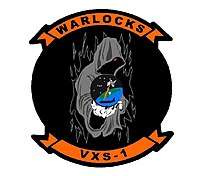VXS-1
Scientific Development Squadron 1 (VXS-1) is a U.S. Navy military support squadron that conducts numerous single-aircraft deployments around the world in support of a wide range of airborne research projects for the U.S. Naval Research Laboratory, U.S. Navy, U.S. Government, and its contracting agencies.
| U.S. Naval Research Laboratory Military Support Division Scientific Development Squadron (VXS) 1 | |
|---|---|
 VXS-1 Insignia | |
| Active | December 2004 – present |
| Country | United States |
| Branch | USN |
| Nickname(s) | Warlocks |
| Commanders | |
| Commander | CDR Jared A. Tharp |
| Commander | CDR Ian J. Lilyquist |
Mission statement
"Scientific Development Squadron (VXS) 1 conducts airborne scientific experimentation and advanced technology development in worldwide operations supporting U.S. Navy and national science and technology (S&T) priorities and war fighting goals. Supporting broadly based, multidisciplinary programs across the full spectrum of scientific research and applied technologies, our focus is toward the maritime application of new and improved airborne data collection techniques, experimental equipment, and system demonstration. While directly supporting scientific programs across the globe, we ensure that our work environment provides for the learning, personal growth, and respect of all our men and women and their families."[1]
History
Formerly known as Flight Support Detachment, VXS-1 was established 13 December 2004, as commissioned by the Office of the Chief of Naval Operations, Notice 5450.[2]
Fleet Operations
_Twin_Otter_Aircraft_(UV-18).jpg)
Manned by Navy officers, enlisted sailors and government and private civilian personnel, the squadron is responsible for the maintenance and security of three uniquely configured NP-3C Orion turboprop research aircraft, a Beechcraft RC-12M Guardrail aircraft, and numerous TigerShark Unmanned Aerial Vehicles (UAVs). In 2019 VXS-1 acquired a UV-18 Twin Otter aircraft, the military equivalent of the DeHavilland DHC-6 — a high-wing, unpressurized twin engine turbine powered aircraft with fixed tricycle landing gear.[3]
_Beechcraft_(RC-12M).jpg)
Located on board the Naval Air Station Patuxent River, Maryland, VXS-1 is responsible for the training, qualifications, and proficiency of all assigned personnel, as well as the maintenance of the research aircraft, and detachment coordination.
Missions
_1_Orion_Aircraft_(NP-3C).jpg)
2004 – The Detachment supported the Antarctic Sea Ice Campaign, flying missions in and around what was formerly known as the Palmer Peninsula on the Antarctic continent. The mission purpose was the evaluation of spatial variability to fully assess how accurately sea ice parameters can be derived based on a study of new ice emissivity, heat, and salinity fluxes over coastal waters and a determination of precise locations of ice edges.[4]
2006 – VXS-1 flew the "Rampant Lion I" survey conducted by Naval Research Laboratory and U.S. Geological Survey scientists as part of an integrated remote sensing survey, mapping approximately two-thirds of the country of Afghanistan.[5]
2008 – The team flew “Rampant Lion II.” Built on data obtained in 2006, the team's modified NP-3D Orion aircraft assisted scientists with a dual focus – developing advanced geospatial collection; and analysis techniques to support the warfighter and economic infrastructure development in Afghanistan.[6]
References
- "VXS-1 Mission Statement". U.S. Naval Research Laboratory. Retrieved 15 April 2020.
- "OPNAV NOTICE 5450" (PDF). Department of the Navy. 13 December 2004. Retrieved 14 July 2010.
- "NRL Introduces Newly Acquired Aircraft for Airborne Research". Naval Research Laboratory. 14 May 2019. Retrieved 19 June 2019.
- Rubino, Lt. John A. (2005). "Flight Support Det becomes VXS-1". Naval Aviation News. Retrieved 14 July 2010.
- Thompson, Rick (26 October 2006). "VXS-1 completes geophysical mapping project in Afghanistan". DCMilitary. Retrieved 14 July 2010.
- "NRL's Rampant Lion ll Survey Builds on Success of Rampant Lion l". Naval Research Laboratory. 26 January 2009. Retrieved 14 July 2010.
External links
| Wikimedia Commons has media related to Scientific Development Squadron 1 (United States Navy). |